|
Why do we expect a Higgs boson? Part I:
Electroweak Symmetry Breaking
Announcement: I’ve been selected as a finalist for
the 2011 Blogging Scholarship. To support this blog, please vote
for me (Philip
Tanedo) and encourage others to do the same! See the bottom
of this post for more information.
In recent posts we’ve seen how the Higgs gives a
mass to matter
particles and force
particles. While this is nice, it is hardly a requirement
there must be
a Higgs boson—maybe particles just happen to have mass and
there’s no “deeper” origin of that mass. In fact, there’s a
different reason why particle physicists are obsessed about
finding the Higgs (or something like it)—that’s called electroweak
symmetry breaking.

The statement that we’d like to understand is the
following:
The Higgs boson breaks
electroweak symmetry spontaneously.
That’s pretty heady stuff, but we’ll take it one
piece at a time. Write it down and use it to impress your
friends. Just be sure that you read the rest of this post so you
can explain it to them afterward. (There’s a second part to the
statement that we’ll examine in a follow up post.)
Electroweak symmetry
You might be familiar with the idea that
electricity and magnetism are two manifestations of the same
fundamental force. This is manifested in Maxwell’s equations and
is often seen written on t-shirts worn by physics
undergraduates. (If you happen to own such a t-shirt, I refer
you to this
article.) Electroweak symmetry is, in a sense, the next step
in this progression, by which the electromagnetic force is
unified with the weak force. This unification into an
‘electroweak’ theory and the theory’s subsequent ‘breaking’ into
separate electromagnetic and weak forces led to the 1979
Nobel Prize in Physics.
So what’s going on here? We know that the force
particle for electromagnetism is the photon, and we know that
the force particles for the weak force are the W+, W-,
and Z bosons.
Permit me to make the a
priori bold
claim that the “unified” set of particles are actually the
following: three W bosons
and something we’ll call a B boson.

What? Now
there are three
W particles? And
what’s this funny B boson;
we never drew any diagrams
with that weirdo in our guide
to Feynman diagrams! Don’t worry, we’ll see shortly that
because of the Higgs, these particles all mix up into the usual
gauge bosons that we know and love. This should at least be
plausible, since there are four particles above which we know
must give us the four electroweak particles that we know: the W+, W-,
photon, and Z.
Note that this new “unified” batch of gauge
bosons don’t really look very unified: The Ws
look completely different from the B.
This illustration reflects an actual physical difference: the Ws
mediate one type of force while the B mediates
a different force. In this sense, the “unified” electroweak
symmetry isn’t actually so unified!
Remark: The next natural step in unifying the
forces would be to
actually unify the Wand B particles
with one another. In fact, mathematically one can find ways
to combine the B,
all three Ws, and
all eight gluons in what is referred to as a grand
unified theory (GUT).
The next step beyond this would be to unify those forces
with gravity, which is referred to in popular literature as
a `theory of everything.’ Unlike electroweak unification,
however, there’s no reason to suspect that either of these
phenomena should be accessible at the TeV scale.
Technical remark: mathematically the unification of
forces falls under the representation theory of continuous
groups (or rather, their algebras). The electroweak group is
the product SU(2)
× U(1). Note that SU(2) has
three generators—this is precisely why there are three W bosons.
ELECTROWEAK SYMMETRY IS BROKEN
In everyday phenomena, we observe electricity and
magnetism as distinct phenomena. The same thing happens for
electromagnetism and the weak force: instead of seeing three
massless Ws
and a masslessB,
we see two massive charged weak bosons (W+ and W-),
a massive neutral weak boson (Z)
and a massless photon. We say that electroweak symmetry is
broken down to electromagnetism.
Now that masses have come up you should suspect
that the Higgs has something to do with this. Now is a good time
to remember that there are, in fact, four Higgs
bosons: three of which are “eaten”
by the weak gauge bosons to
allow them to become massive. It turns out that this “eating”
does more that that: it combines the ‘unified’ electroweak
bosons into their ‘not-unified’ combinations!
The first two are easy; the W1 and W2 combine
into the W+ and W- by
“eating” the charged Higgs bosons. (Technically we should now
call them “Goldstone” bosons.)

We’ll say a bit more about why eating a
Higgs/Goldstone can cause the W1 and W2 particles
to combine into, say, a W+.
For now, note that the number of “degrees of freedom” match.
Recall that ‘degree of freedom’ roughly translates in to the
number of distinct particle states. In the electroweak theory we
have two massless gauge bosons (2 × 2 polarizations = 4 degrees
of freedom) and two charged Higgses (2 degrees of freedom) for a
total of six degrees of freedom. In the broken theory, we have
two massive gauge bosons (2 × 3 polarizations) which again total
to six degrees of freedom.
A similar story goes through for the W3, B,
and H0 (recall
that this is not the same as the Higgs
boson, which we write with a lowercase h).
The W3 and B combine
and eat the neutral Higgs/Goldstone to form the massive Z boson.
Meanwhile, the photon is the leftover combination of the W3 and B.
There are no more Higgses to eat, so the photon remains massless.

It’s worth noting that the Ws
didn’t combine into charged
Ws until electroweak symmetry breaking. This is because
[electric] charge isn’t even well-defined until the electroweak
theory has broken to electromagnetic theory. It’s only after
this breaking that we have a photon that mediates the force that
defines electric charge.
ELECTROWEAK SYMMETRY IS BROKEN SPONTANEOUSLY
Alright, we have some sense of what it means that
“electroweak symmetry” is broken. What does it mean that it’s
broken spontaneously,
and what does this whole story have to do with the Higgs? Now we
start getting into the thick of things.
The punchline is this: the Higgs vacuum
expectation value (“vev”
for short) is what breaks electroweak symmetry. You might want t
quickly review this
post where we first introduced the Higgs vev in
the context of particle mass. For those who like hearing fancy
physics-jargon, you can use the following line:
The Higgs vev is the
order parameter for electroweak symmetry breaking.
First, let’s see why the Higgs obtains a vacuum
expectation value at all. We can draw nice pictures since the
vev is a classical quantity. The potential is
a function that tells you the energy of a particular
configuration. You might recall problems in high school physics
where you had to find the minimum of an electric potential, or
determine the gravitation potential energy of a rock being held
at some height. This is pretty much the same thing: we would
like to draw the potential of the Higgs field. (To be
technically clear: this is the potential for the combined bunch
of four
Higgses.)
Let’s start with what a “normal” potential looks
like. Here on the x and y axes
we’ve plotted the real and imaginary parts of a field ϕ; all
that’s important is that a point on the x-y plane
corresponds to a particular field configuration. If the particle
is sitting at the origin (in the middle) then it has no vacuum
expectation value, otherwise, it does obtain a vacuum
expectation value.

On the z axis
we draw the potential V(ϕ).
The particle wants to roll to the minimum of the potential, so
in the cartoon above—the “normal” case—the particle obtains no
vacuum expectation value. I’ll mention in passing that concave
of the potential is related to the particle’s mass.
Now let’s examine what the Higgs potential looks
like. Physicists refer to this as the “Mexican hat” potential
(These images are based on an illustration that is often used in
physics talks. Unfortunately I am unable to find the original
source of this graphic and ended up re-drawing it.):

What we observe is that the origin is no longer a
minimum of the potential. In other words, the Higgs wants to
roll down the hill where it can have lower potential energy. I’m
not telling you why the
potential is shaped this way (there are a few plausible
guesses), and within the Standard Model this is an assumption
about the Higgs.
So the Higgs must roll off of its hill into the
ravine of minimum potential energy. This happens at every point
in spacetime, meaning that the Higgs vev is “on” everywhere and matter
particles can bounce off it to
obtain mass. There’s something even more important though: this
vev breaks
electroweak symmetry.
In the cartoons above, there’s something special
about the origin. If the particle sits at the origin, you can do
a rotation about the x-y plane
and the configuration doesn’t change. On the other hand, if the
particle is off of the origin, then doing a rotation will send
the particle around along a circular trajectory (shown as a
solid green line). In other words, the rotational symmetry is
broken because the physical configuration changes.

The case of electroweak symmetry is the same,
though it requires more dimensions than we can comfortably draw.
The point is that there are originally four Higgses which are
all parts of a single “Higgs.” In the unified theory where
electroweak symmetry is unbroken, these four Higgses can be
rotated into one another and the physics doesn’t change.
However, when we include the Mexican hat potential, the system
rolls into the bottom of the Mexican hat: one of the Higgses
obtains a vev while the others do not. Performing a “rotation”
then moves the vev from one Higgs to the others and the symmetry
is broken—the four Higgses are no longer being treated equally.
Now to whet your appetite for my next post: you
can see that once electroweak symmetry is broken, there is a
“flat direction” in the potential (the green circle). Remember
when I said that the concave of the potential has to do with the
particle’s mass? The fact that there is a flat direction means
that there are massless particles. In fact, for the Higgs, there
are three flat directions that correspond to—you guessed it—the
three massless Higgs/Goldstone particles which are eaten by the
weak gauge bosons: the H+,
H-, and H0.
The fourth Higgs—the particle that we usually call the Higgs—corresponds
to an excitation in the radial direction where there is a
concave, so the Higgs boson has mass.

DO WE REALLY NEED A
HIGGS?
Okay, so if you’ve followed so far, you have an
idea of how electroweak symmetry breaking explains how the
massless W and B bosons
combine with the Higgses to form the usual W+, W-, Z, and
photon. We’ve also reviewed how matter particles get mass (by
bumping into the resulting vev) and how some of those gauge
bosons got mass (by eating some of the Higgses). But was all of
this necessary, or did we just cook it all up because we liked
the idea of electroweak unification?
We will see in one of my follow up posts that in
fact, electroweak symmetry breaking is almost necessary
for our theory to make sense. (I’ll quantify the “almost” when
we get there, but the technical phrase will be “perturbative
unitarity.”) Note that I said that electroweak symmetry breaking
is the important thing. Throughout this entire post you could
have replaced the Higgs boson with “something like it.” There
are plenty of theories out there with multiple Higgs bosons, no
Higgs bosons, or generically Higgsy-things-but-not-quite-the-Higgs.
That’s fine—in all of these theories, the “Higgsy-thing” always breaks
electroweak symmetry. In doing so, you always end
up with Goldstone bosons that are eaten by the W+, W-, and Z.
And you always end up with some kind
of particle like the Higgs
that we expect to find at the LHC.
Source :Quantum
Diaries
Why do we expect a Higgs boson? Part II:
Unitarization of Vector Boson Scattering
Hi everyone—it’s time
that I wrap up some old posts about the Higgs boson. Last
December’s tantalizing results may end up being the first
signals of the real deal and the physics community is
eagerly awaiting the combined results to be announce at the Rencontres
de Moriond conference
next month. So now would be a great time to remind ourselves
of why we’re making such a big deal out of the Higgs.
Review of the story so far
Since it’s been a while since I’ve posted
(sorry about that!), let’s review the main points that we’ve
developed so far. See the linked posts for a reminder of the
ideas behind the words and pictures.
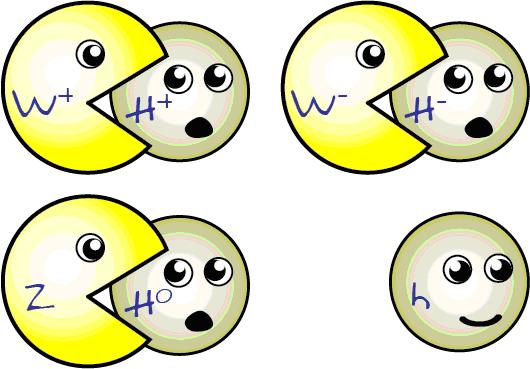
There’s not only one, but four particles
associated with the Higgs. Three of these particles “eaten”
by the Wand Z bosons
to become massive; they form the “longitudinal
polarization” of those massive particles. The fourth
particle—the one we really mean when we refer to The Higgs
boson—is responsible forelectroweak
symmetry breaking. A cartoon picture would look
something like this:

The solid line is a one-dimensional version of the Higgs
potential. The x-axis
represents the Higgs ”vacuum
expectation value,” or vev.
For any value other than zero, this means that the Higgs
field is “on” at every point in spacetime, allowing fermions
to bounce off of it and hence become
massive. The y-axis
is the potential energy cost of the Higgs taking a
particular vacuum value—we see that to minimize this energy,
the Higgs wants to roll down to a non-zero vev.
Actually, because the Higgs vev can be any complex number,
a more realistic picture is to plot the Higgs potential over
the complex plane:
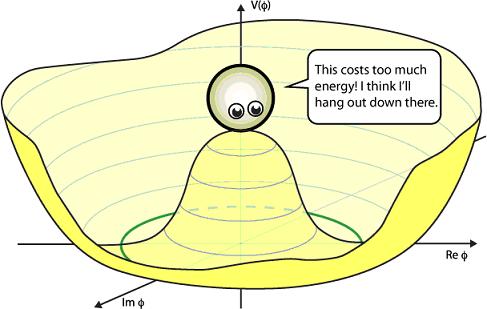
Now the minimum of the potential is a circle and the Higgs
can pick any value. Higgs particles are
quantum excitations—or ripples—of the Higgs field. Quantum
excitations which push along this circle are called Goldstone
bosons, and these represent the parts of the Higgs
which are eaten
by the gauge bosons. Here’s an example:

Of course, in the Standard Model we know there are three Goldstone
bosons (one each for the W+, W-,
and Z),
so there must be three “flat directions” in the Higgs
potential. Unfortunately, I cannot fit this many dimensions
into a 2D picture.  The
remaining Higgs particle is the excitation in the not-flat
direction: The
remaining Higgs particle is the excitation in the not-flat
direction:
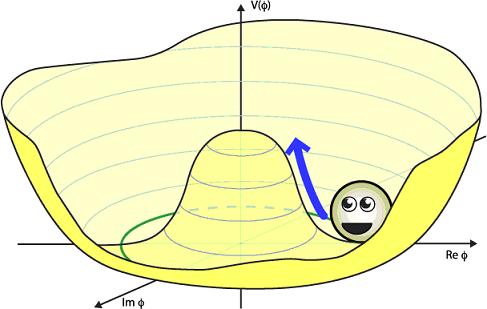
Usually all of this is said rather glibly:
The Higgs boson is the particle which is responsible for
giving mass.
A better reason for why we need the Higgs
The above story is nice, but you would be
perfectly justified if you thought it sounded like a bit of
overkill. Why do we need all of this fancy machinery with
Goldstone bosons and these funny “Mexican hat” potentials?
Couldn’t we have just had a theory that started
out with
massive gauge bosons without needing any of this fancy “electroweak
symmetry breaking” footwork?
It turns out that this is
the main reason why we need the Higgs-or-something-like it.
It turns out that if we tried to build the Standard Model
without it, then something very nefarious happens. To see
what happens, we’ll appeal to some Feynman diagrams, which
you may want to review if
you’re rusty.
Suppose you wanted to study the scattering of two W bosons
off of one another. In the Standard Model you would draw the
following diagrams:

There are other diagrams, but these two will be sufficient
for our purposes. You can draw the rest of the diagrams for
homework, there should be three more that have at most one
virtual particle. In the first diagram, the two W bosons
annihilate into a virtual Z boson
or a photon (γ) which subsequently decay back into two W bosons.
In the second diagram it’s the same story, only now the W bosons
annihilate into a virtual Higgs particle.
Recall that these diagrams are shorthand for mathematical
expressions for the probability that the Wbosons
to scatter off of one another. If you always include the sum
of the virtual Z/photon
diagrams with the virtual Higgs diagram, then everything is
well behaved. On the other hand, if you ignored the Higgs
and only included
the Z/photon
diagram, then the mathematical expressions do not behave.
By this I mean that the probability keeps growing and
growing with energy like the monsters that fight the Power
Rangers. If you smash the two W bosons
together at higher and higher energies, the number
associated with this diagram gets bigger and bigger. If
these numbers get too big, then it would seem that
probability isn’t conserved—we’d get probabilities larger
than 100%, a mathematical inconsistency. That’s a problem
that not even the Power Rangers could handle.
Mathematics doesn’t actually break down in this
scenario—what really happens in our “no Higgs” theory is
something more subtle but also disturbing: the theory
becomes non-perturbative (or
“strongly coupled”). In other words, the theory enters a
regime where Feynman
diagrams fail. The simple diagram above no longer
accurately represents the W scattering
process because of large corrections from additional
diagrams which are more “quantum,” i.e. they have more
unobserved internal virtual particles. For example:
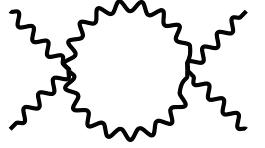
In addition to this diagram we would also have even more
involved diagrams with even more virtual particles which
also give big corrections:

And so forth until you have more diagrams than you can
calculate in a lifetime (even with a computer!). Usually
these “very quantum” diagrams are negligible compared to the
simpler diagrams, but in the non-perturbative regime each
successive diagram is almost as important as the previous.
Our usual
tools fail us. Our “no Higgs theory” avoids mathematical
inconsistency, but at the steep cost of losing predictivity.
Now let me be totally clear: there’s nothing “wrong”
with this scenario… nature may very well have chosen
this path. In fact, we know at least one example where
it has:the
theory of quarks and gluons (QCD) at low energies is
non-perturbative. But this is just telling us that
the “particles” that we see at those energies aren’t
quarks and gluons since they’re too tightly bound
together: the relevant particles at those energies are
mesons and baryons (e.g.pions and protons). Even though
QCD—a theory of quarks and gluons—breaks down as a
calculational tool, nature allowed us to describe
physics in terms of perfectly well behaved
(perturbative) “bound state” objects like mesons in aneffective theory
of QCD. The old adage is true: when nature closes a
door, it opens a window.
So if we took our “no Higgs” theory seriously, we’d be in an
uncomfortable situation. The theory at high energies would
become “strongly coupled” and non-perturbative just like QCD
at low energies. It turns out that for W boson
scattering, this happens at around the TeV scale, which
means that we should be seeing hints of the substructure of
the Standard Model electroweak gauge bosons—which we do not.
(Incidentally, the signatures of such a scenario would
likely involve something that behaves somewhat like the
Standard Model Higgs.)
On the other hand, if we had the Higgs and we
proposed the “electroweak symmetry breaking” story above,
then this is never a problem. The probability for W boson
scattering doesn’t grow uncontrollably and the theory
remains well behaved and perturbative.
GOLDSTONE LIBERATION AT HIGH ENERGIES
The way that the Higgs mechanism saves us is
somewhat technical and falls under the name of theGoldstone
Boson Equivalence Theorem. The main point is that
our massive gauge bosons—the ones which misbehave if there
were no Higgs—are actually a pair of particles: a massless
gauge boson and a massless Higgs/Goldstone particle which
was “eaten” so that the combined
particle is massive. One cute way of showing this is to
show the W boson
eating Gold[stone]fish:
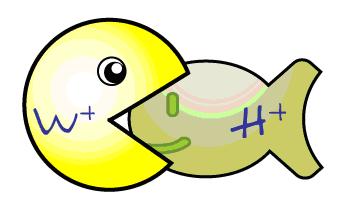
Indeed, at low energies the combined “massless W plus
Goldstone” particle behaves just like a massiveW.
A good question right now is “low compared to what?” The
answer is the Higgs vacuum expectation value (vev),
i.e. the energy scale at which electroweak symmetry is
broken.
However, at very high energies compared to the Higgs vev,
we should expect these two particles to behave independently
again. This is a very intuitive statement: it would be very
disruptive if your cell phone rang at a “low energy”
classical music concert and people would be very affected by
this; they would shake their heads at you disapprovingly.
However, at a “high energy” heavy metal concert, nobody
would even hear your cell phone ring.
Thus at high energies, the “massless W plus
Goldstone” system really behaves like two different
particles. In a sense, the Goldstone is being liberated from
the massive gauge boson:

Now it turns out that the massless W is
perfectly well behaved so that at high energies. Further,
the set of all four Higgses together (the three Goldstones
that were eaten and the Higgs) are
also perfectly well behaved. However, if you separate the
four Higgses, then each individual piece behaves poorly.
This is fine, since the the four Higgses come as a package
deal when we write our theory.
What electroweak symmetry breaking really does is that it
mixes up these Higgses with the massless gauge bosons. Since
this is just a reshuffling of the same particles into
different combinations, the entire combined theory is still
well behaved. This good behavior, though, hinges on the fact
that even though we’ve separated the four Higgses, all four
of them are still in the theory.
This is why
the Higgs (the one we’re looking for) is so important: the
good behavior of the Standard Model depends on it. In fact,
it turns out that any well behaved theory with massive gauge
bosons must have come from some kind of Higgs-like
mechanism. In jargon, we say that the Higgs unitarizes longitudinal
gauge boson scattering.
For advanced readers: What’s happening here is
that the theory of a complex scalar Higgs doublet is
perfectly well behaved. However, when we write the
theory nonlinearly (e.g. chiral perturbation theory,
nonlinear sigma model) to incorporate electroweak
symmetry breaking, we say something like: H(x)
= (v+h(x)) exp (i π(x)/v). The π’s are
the Goldstone bosons. If we ignore the Higgs, h, we’re
doing gross violence to the well behaved complex scalar
doublet. Further, we’re left with a non-renormalizable
theory with dimensionful couplings that have powers of
1/v all
over the place. Just by dimensional analysis, you can
see that scattering cross sections for these Goldstones
(i.e. the longitudinal modes of the gauge bosons) must
scale like a positive power of the energy. In this
sense, the problem of “unitarizing W boson
scattering” is really the same as UV completing a non-renormalizable
effective theory. [I thank Javi S. for filling in this
gap in my education.]
CAVEAT: HIGGS VERSUS HIGGS-LIKE
I want to make one
important caveat: all that I’ve argued here is that we need
something to play the role ofthe Higgs
in order to “restore” the “four well behaved Higgses.” While
the Standard Model gives a simple candidate for this, there
are other theories beyond the Standard Model that give
alternate candidates. For example, the Higgs itself might be
a “meson” formed out of some strongly coupled new physics.
There are even “Higgsless” theories in which this
“unitarization” occurs due to the exchange of new gauge
bosons. But the point is that there needs to be something that
plays the role of the Higgs
in the above story.
Source :Quantum
Diaries
1 2 3 4 5 6 7 8 9 10 Newest
articles
|
![]() The
remaining Higgs particle is the excitation in the not-flat
direction:
The
remaining Higgs particle is the excitation in the not-flat
direction: